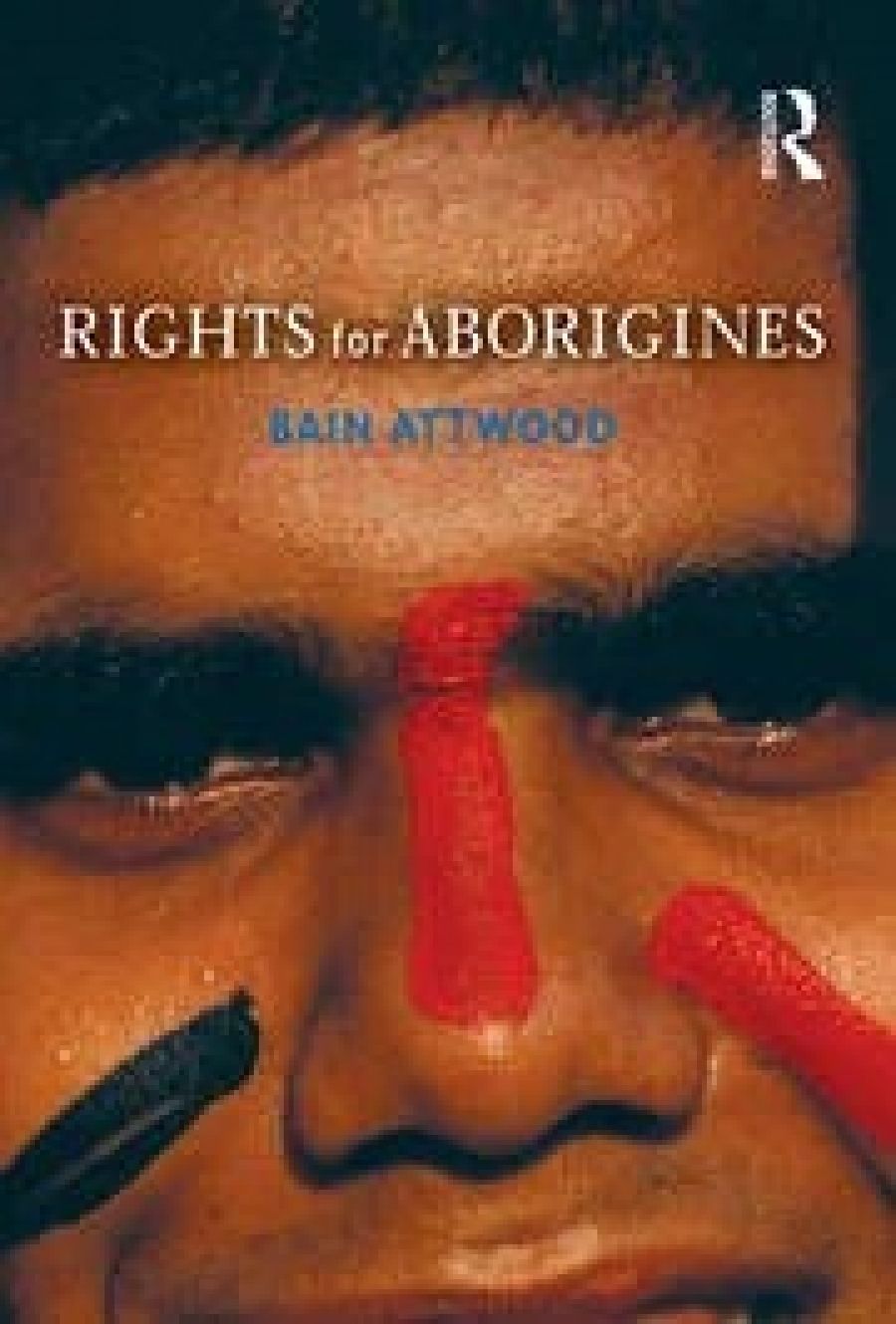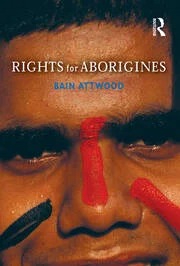
- Free Article: No
- Contents Category: Indigenous Studies
- Review Article: Yes
- Article Title: Touching the Sides
- Online Only: No
- Custom Highlight Text:
John Howard, someone has remarked, deserves to be remembered for his shabby key to political success: he gave Australians permission to leave their consciences in the cupboard. Paul Keating, who knew what was coming with Howard, said that, if you have to pick a horse in any political race, back self-interest because at least you’ll know he’ll be trying. Bain Attwood’s important new book is about the struggle to right the nation’s greatest wrong in the hundred years before Keating and Howard began their political careers. It is an inspiring story about a tiny minority of fighters and a depressing reminder of how long self-interest and indifference kept consciences safely locked away.
- Book 1 Title: Rights for Aborigines
- Book 1 Biblio: Allen & Unwin, $39.95pb, 424pp
- Book 1 Cover Small (400 x 600):

- Book 1 Cover (800 x 1200):

On the eve of World War II, Aborigines trying to sustain a community on the Murray near Echuca walked off their reserve in an attempt to break through the complacency. ‘Children have been dying. We counted up – 25 in one year and 10 months, mostly under 18 months old.’ The manager, they said, was treating them like animals rather than human beings. He went round the reserve with a gun. For years they had often been semi-starved. Their most respected and statesman-like leader, William Cooper, said: ‘We are not an enemy people, and we are not in Nazi concentration camps. Why should we be treated as though we were?’
Cooper was a measured man compared with some of the younger leaders. How could they make Australians understand that the Aboriginal people would only have left the reserve if conditions were unbearable? Would the majority ever understand the constant intimidation and degradation, the affronts to dignity, the panic when the news swept through the reserve that once again the children were going to be taken away? An earlier raid, when Margaret Tucker and other children were seized by police while the men were sent away rabbiting, was a raw wound. We remember Tucker as an elderly woman, quietly describing her kidnapping and the anguish of her mother in Lousy Little Sixpence, and the episode about the Cumeroogunga walk-off in Women of the Sun. We need reminding about the grief, the bravery and desperation that brought mostly unsympathetic press coverage and little public support in 1939.
Attwood structures the story around such key episodes of resistance, beginning in the late nineteenth century with the (unsuccessful) fight to keep a tiny allocation of reserve land near Melbourne. From those first deputations and petitions, we follow the building of the movement for Aboriginal rights that changed the nation in the last decades of the twentieth century. The heroes and heroines are mainly unknown to those who read about Geoff Clark and resent particular rights for, and expenditure on, Aborigines.
Part of Attwood’s importance among Australia’s historians is his project of tracing Aborigines’ evolving consciousness of the new identity that would be formed in their encounter with the invaders. His first book, The Making of the Aborigines, argued that ‘Aborigines’ with a capital ‘A’ came into being through their relationships with Europeans; before that, they were ‘aborigines’, many indigenous peoples without a sense of shared purpose. (If you find that conceptually or typographically vexing, this book will vex you further.)
Some people will be surprised by how much of the specific history is set in Victoria and on the border with New South Wales, where the small indigenous population had sustained a genocidal onslaught of disease, settlement and killing. Justice Olney’s pronouncement to the Yorta Yorta, who sought to sustain their ancient claim to the lands round Cumeroogunga, has become one of the famous lines of the national heritage. ‘The tide of history’, he said – not one act of deliberate destruction after another – had swept their right to the land away.
Later we move to the north, where the black population has survived and established its position in much greater numbers. However, this story makes plain that the most traumatised Koori communities of the south were the source of resistance, political activism and a painfully advanced national awareness. ‘Poor bugger me Gurindji’, an even more famous line of the struggle, would not have been heard without the century of campaigning that preceded it.
Without the non-Aboriginal activists who engaged themselves in what most Australians regarded as a lost cause, it might not have been heard, either. Ted Egan’s song was only the most memorable of many actions of solidarity from those always labelled ‘outside agitators’ by Aborigines’ opponents. Attwood pays just attention to the role and motivation of supporters as diverse as Mary Bennett, Donald Thompson and Frank Hardy. From Christian interventionists such as the mission superintendent John Green to Communist activists such as Hardy, whose political and literary skills were also deployed in the Northern Territory campaign, white Australians helped those they saw as black brothers and sisters (in Christ or in the union movement) to find a sympathetic ear. We remember Faith Bandler and Doug Nicholls; we should also be able to recall Shirley Andrews and Gordon Bryant.
Attwood demonstrates that representatives of the dominant society were crucial players in the struggle for Aboriginal rights and that Aboriginal leaders were adept at adjusting to changes in the national and international context. By 1967 they had learned to play on a sense that the world was watching: to the tune of ‘Walzing Matilda’, the Yes campaign in the referendum sang ‘Vote Yes, Australia, Vote Yes, Australia, The eyes of the world are upon us today’. Yet there is little attention to social or cultural change in Australia, the opening to new influences that was the context of the political change needed for Aboriginal rights to be acknowledged. Perhaps that will be more prominent in a further instalment, from Gough Whitlam to the present. That might also be the place for a more critical look at the problems brought with the wins (equal pay, equal access to alcohol) and the unresolved status of some fundamental arguments. Paul Hasluck no doubt did believe that assimilation was the only genuine form of equal rights, and thousands still agree with him.
Rather than depending on sensationalism, histories of Australia and its Aboriginal people can rely on long and careful research, fair rather than tendentious interpretation of sources, and a humane reading of actions and aspirations. An individual history such as Rights for Aborigines demonstrates again how silly the talk of orthodoxy or ‘fabrication’ in ‘Aboriginal history’ is. Attwood declares ‘a commitment to addressing the wrongs the colonial past has bequeathed to the present’ and to a discipline that requires ‘distancing and objectifying’. He does not dwell on atrocity or the endemic trauma that Aborigines endured. He seeks to show how a century of political struggle developed, and the arduous breakthroughs it achieved.
Only a handful of Australians will read this book with the recognition that comes from participation in the struggle. The epic at the centre of Australian history has been so rarely told and remains largely unknown because the issues were as marginalised as the people were. Even during the Fraser government, after all the advances won up to then, Andrew Peacock professed support for the concerns raised by a delegation of constituents, but said of his cabinet colleagues, who no doubt knew their constituents: ‘Wouldn’t touch the sides.’ After Mabo, ‘Reconciliation’ and the Sorry Days, we seem to be back where we were.


Comments powered by CComment